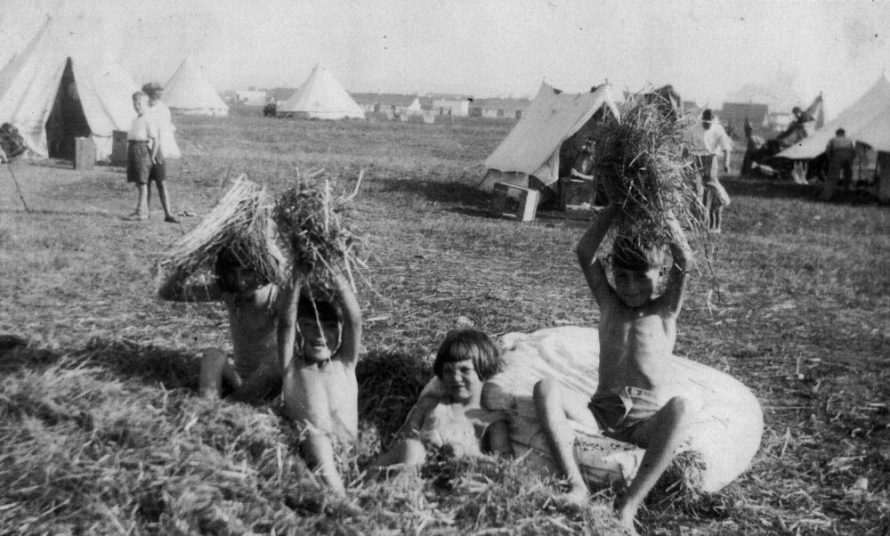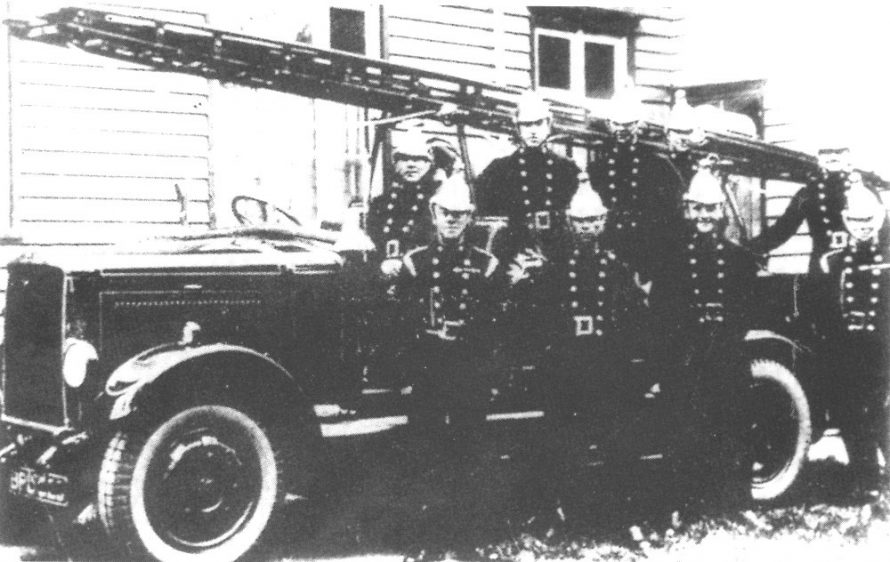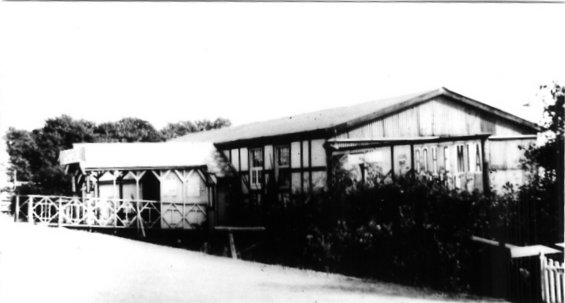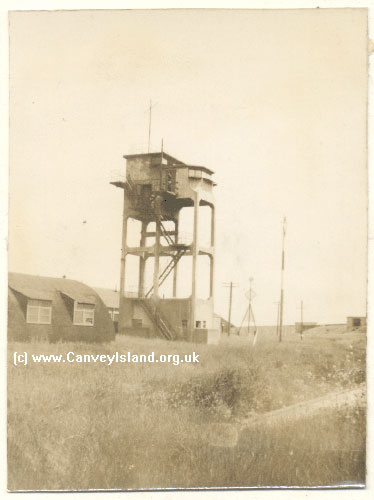Memories of my childhood on Canvey Island
Written by Bill Gower
Canvey Island in the early 1930’s and before that was a dumping ground for barge loads of London’s waste and refuse. Human sanitation was non existent, lavatories were a large bucket under a seat in a small shed located at the bottom of the garden. When the bucket was full it had to be lifted out and the contents tipped in a hole in the garden. Everyone had this type of toilet and everyone had a garden full of holes covered in afterwards of course, but you never knew where to make the next step.
Main running water was also non existent, the water we got was rain, which ran off the corrugated iron roofs, down a pipe and into a big galvanised tank standing on wooden stilts, everyone had one of these as well, this was our water supply. We made our tea with it, washed our spuds with it, washed our clothes with it and washed ourselves with it. The deal was to climb up and clean these tanks out during the summer, we did this like everyone else and found a dead cat in ours, it had been floating up and down according to the rainfall and level of the water in the tank and this is true.

Admiral Jellicoe
There was no such thing as electric light, it had not yet arrived. There was no gas supply as yet and of course no sewerage. Ditches and dykes were all over the place to drain off water in the fields and gardens, there was only one road made up, and this was the main one that started at the Canvey side of Benfleet creek end ended at the Admiral Jellico pub in Leigh Beck. Onwards from here it was an unmade road usually very muddy due to the Canvey Supply horse and carts coming and going from the Canvey Point.
The buses were individually owned and operated independently, bus stops were anywhere a bunch of people gathered, which was usually at the corners, but the drivers would pull up if signalled to do so. These buses were very small and most had an escape door at the back, drivers would try to cram as many people in his bus as it would take and should another driver roll up at the same time he would get out of his bus and open the rear door of the one in front and pull some excess passengers out so that they could ride in his bus instead, sometimes there were punch ups over this.
People bought plots of land for fivers and tenners, ownership would change hands in a pub over a few drinks, probably a few too many. Most of these plots being used for holiday makers, some very old dwellings appeared in them such as a real railway carriage, and old London bus, world war one army bell tents, metal circular shape rounded huts, old van bodies, anything which kept the rain off was good enough for the weekend holiday maker to enjoy. There were four pubs, The Lobster Smack, The Red Cow (now King Canute), The Haystack and the Admiral Jellico. The Jellico was a comparatively new building and very big.

Camping Ground
At the Haystack corner there was no road access to the beach, then known as Shellbeach, there was a sandy track that people could walk along to get to the beach, in fact there was a very large wooden gate across the road to stop vans using the track, this gate being across Fisks Corner. There was no Casino, Monico or any other buildings at the beach end, and the Esplanade as we know it today was all unmade with well worn footpaths of sand. But there was an amusement arcade on the corner of May Avenue the seafront end. This was owned by Mr Andrews and it was known as Andrews Fair, he had a few roundabouts and swings at the rear and the usual mixture of penny slot machines of the ‘What the butler saw’ style. There were also small trading huts around selling teas, cakes, wooden spades and buckets for the children.
On Saturday nights the Canveyites would get togged up as best they could and make their way to the nearest pub or social club wellington boots being an essential part of the dress, shoes carried in a bag ready to put on in the pub. The hurricane storm lamp was also included for use on the way home, some by folk well and swearing because their lamp had blown out. There were six heavy duty storm lamps used as street lights, six for all the Island. One at the Jellico, one at Gains corner, one at Lakeside corner, one at Haystack corner, one at Red Cow in the village, and one at Lunns Stores at Winter Gardens, or sixty acres as it was also known as. There was a lad employed by the Council to go round on his bike with a can of paraffin oil, some cleaning rag and some matches. He had to turn the lamps out in the morning, clean the glass, refill the lamp with oil and hang it back on the pole, at night he had to go round again and light them all up.

The First Fire Engine
There was just one Policeman and his name was Mr. Peagram (see picture below) he lived in the Police house come station, on the same site as it is now but his was a bungalow, he rode around on a bike and kept law an order without any help from the Law Courts. The Fire Station nearby was by volunteer and part time only, very often a rocket maroon was set off with a bang and all the volunteers would leave whatever they were doing and then rush off on their bikes to the Fire Station. The Fire Engine was a bit ancient but it got there towing a water truck for the supply of water, it was a bit of a hit and miss affair but the volunteers were solid enough. Quite a few Islanders were real characters, A chap named Arthur Read was well known for his generosity, he would work all the week and then spend all his wages on beer at the weekends, he would physically run across a field chasing a rabbit for his dinner. Wally Brown was another, he had a stutter and ran a tea shop, there were many others to make up the party.
The Council was known as Canvey Island Urban District Council and it had its offices at a chalet bungalow on the corner of Fairlop Avenue, the name of the bungalow being ‘Fairlawn’ there were not many councillors, no one seemed to submit any plans for buildings because people put up what they fancied at that time, but such freedom was not to last.

Fielder bungalows
There were some estates of houses in progress. The Fisk Estate at Driveway and the Fielder Estate at Clifton Avenue and Southwick Road and these were considered to be the modern buildings of the day, some still exists. A general picture is now therefore explained and if you have a good head for imagination then you will have some idea what Canvey was like in those days.
On Canvey the Bohemia Hall near Gains corner still opened week for ‘Pettits Popular Pictures’ for the kids, this being a flickering film on the screen showing Charlie Chaplin in custard pie fights and other such ancient films. This was in any case a comical affair when the elderly Mr Pettit would be at the recr of the dark hall with his hand cranking the camera and directing the film over the childrens heads to the screen in front of them, sometimes the film would begin to wander off the screen to the extent that half of it was being shown on the screen and the other half on the ceiling, but the kids enjoyed it.

Bohemia Hall
Perhaps the most distinctive change that year was the buses, the old one as previously described were being sold off or transferred somewhere else and the replacements took on a new look, all single deckers still, but rather longer and all painted the same colour of green. They were not new ones but we accepted them as being a good improvement. The bus stops were also put in a place of recognition, all bearing a ‘Bus Stop’ sign. In addition to this the timing was nearer the mark and more reliable. A new system to monitor the departure and arrival times of buses was introduced and it came from a big clock housed in a weather proof wooden frame on stilts in the front garden of the Council Offices of ‘Fairlawn’ on the corner of Fairlop Avenue. This position was of course actually on the main road and when the bus came to it then all the conductors had to do was to walk a few steps and place his bus time card in the slot of the clock, pull a trigger or lever and the time was then stamped on the card. This had to be done every time and on each journey to Benfleet and each bus had to do it. So if a bus was running a bit late on one journey, then the driver knew and would make it up on the next one, this of course made a better service.
All this change was due to our previously independent bus operators forming an amalgamation with the Hadleigh bus company owned and operated by a man named Bridges. He had a small fleet of his own that operated in the Hadleigh to Southend area, the Canvey buses continued to operate on Canvey only but it was a vast improvement and people could make bus connections easier.
This particular bus was a noisy old beast and it could be heard in those open uncrowded days at Canvey in fact from Lakeside corner it could be heard grinding its way through the gears when it left Leigh Beck.
One day it broke down outside Gaylards garage in Canvey High Street as it was on its way to Benfleet. The fitter Jack Bradbury, came out of the garage with a handful of tools to get the engine restarted and had to sit on the big front mudguard with the side bonnet up and tinkering with the engine to keep it going, he went all the way to Benfleet and back like this and in those days this was news.
Shifting on a bit more to 1932 this was a year of speculation about the Island needing services of main running water, electricity gas, and main sewerage. Being a long time ago it is not easy to say which of these arrived first, or for that matter exactly when. But what is quite distinctive to us youngsters of the day was the electric street lights when they were switched on for the first time. For some time there had been gangs of workmen digging up all over the place, and when the lamp posts were fixed they remained unlit for weeks until we got the news that on a given date they would be switched on. This in turn created some sort of a carnival attitude among the locals especially us youngsters, on the selected night we all gathered together and waited outside our nearest lamp post and waited. Suddenly it came on, so did all the others along the road, what a sight for sore eyes, the cheers echoed around the town, it was a night of joy. After this it took quite a long time to expand the services to the outer side roads, years in fact, but it got there in the end.
The next to follow was the main water supply, all of this took ages as well but it was not such a spectacular event and it seemed as if the island was being dug over with trenches everywhere, then came the gas this being the same. But the largest operation of all was the main sewerage, this was the last of the essential services to be laid on Canvey Island. This began with ripping up one side of the main road right across Canvey. Gangs of men dug very deep into the Canvey soil, so deep in fact that water pumps had to be used continuously to pump the water out of the trenches that the gangs were digging up, the trenches having to be shored up with huge planks of timber, and small wooden platforms were built inside the trenches as the men dug deeper, each shovelful of soil being passed upwards in relays on to the stepped up platforms and finally to the road where it was loaded into lorries and horse and cars and taken away, when the trenches were deep enough then a fleet of small cranes lowered the sewer pipes to the bottom where they were connected up for miles, it all seemed to go on for years in fact some areas never got it at all until proper residential estates were developed.

Army Towers in the Fort at Thorney Bay WW2
By no means has every change been mentioned in this tale of Canvey since 1930 but those you read about are some of the highlights, and there is just one more to come and which many people especially young people will know nothing of or even have heard about, and that is the Military fortress that was built here commencing from near enough 1935. Also, when describing this very great massive construction I have to bring myself in with the details because I was involved in it all.
It was sited tight up against the seawall on the far side of the now Fielders caravan holiday Camp, or Thorney Bay camp if you like, and rather a bit nearer to Hole Haven. Quite a lot of the sea wall had to be dug away on the inner side and then shored up with concrete and pilings and this was only a start. All the materials for this site had to be brought on to the Island by road and dumped in a chosen clear field at the main road end of Kitkatts Road, this being the nearest access to the site which was then one and a half miles away through Kitkatts road, the Thorney Bay duck pond and many fields afterwards. So a small gauge railway line was constructed and laid all this distance, it was to be used to convey all the construction materials, there was no other way to get there.

Army Towers in the Fort at Thorney Bay WW2
In 1936 a bunch of my pals and myself got a job with the firm who were to build it, we started of f as labourers and after a few weeks the railway was completed, the diggers arrived, the concrete mixers, the winches, in fact all the gear necessary to make a start, all this had to be dismantled and taken by rail to the site and then reassembled again in order to get on with the construction.
After about three months some sort of pattern was taking place and we understood that the fort was to hold two great big six inch bore naval guns pointing out to sea, in addition to this there was to be quite a few small gun emplacements such as antiaircraft guns and machine guns and also search lights, this will give some idea of the size of it all.
I am not sure how it happened but one day one of the bosses a Mr. Clark asked me if I would like the job of driving one of the locomotives, I think the only reason he chose me was because I could drive a car and had been seen shifting one out of the workmens way on one occasion, and he thought I would be a reasonable one to drive a train. Of course I was highly delighted at this and within a week or so my locomotive arrived, it was a German make named ‘Arn Jung’ in fact all the instruments and reading were in German as well. I was given a couple of hours instruction on how to drive it and then had to get on with it but being only nineteen years old I had the enthusiasm and interest to learn quickly.

‘Arn Jung’ Locamotive
As a loco driver I had to haul a train of small skip size wagons filled with ballast and cement and all other construction materials. The loco was a diesel and smoked a lot as it took the strain of pulling such a load but it did the job day in and day out. Over the next eighteen months I must have hauled thousands of tons of the stuff up to the site, it was a job I enjoyed and got a lot of envy from my by pals who where still labouring with shovels.
But this exciting job for me came to an abrupt end on a Saturday when I fell from the top of a loading gantry and broke my leg so badly that I was out of action for the next sixteen months, by which time the fortress was almost finished, after which it was the occupied by the military. Within a year after I had started walking about without the aid of crutches and sticks the war started, within six months I was a soldier.
Six and a half years when the war was over, the fort was still here, so were the big massive guns but there had not been a German warship in sight to fire at all the time. Eventually the fort was demolished and the seawall put back to its original form, the remaining part of the Canvey landscape was also reinstated back to normality. Anyone born after the war would know nothing of all this, that’s why I have explained it all.
In retrospect that fort must have cost a few bob one way or another, and all for nothing. I don’t know who paid for it, but I’ve been in the red at the bank ever since!





Comments about this page
Wonderfull memories – thanks!
what an interesting & enjoyable story.
I thoroughly enjoyed these experiences. How many other delights have you hidden on these sites?
Thank you for all the details you have writen. So many I did not know about.
Add a comment about this page